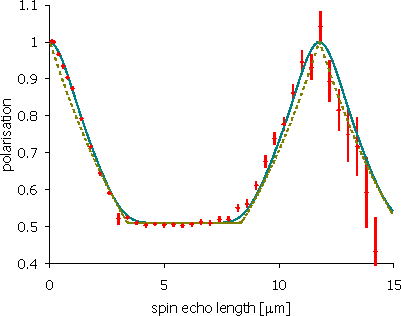SESANS shows directly structure of a grating
In the figure we show SESANS measurements on a silicon line-grating with a period of 12 mm, a ridge height of 40 mm and a ridge width of 4 mm. For the measurement of such a one-dimensional structure we expect the autocorrelation function of the density profile of the grating. This is the auto-convolution of a rectangular grid, which results in a triangular grid with the same period and with a base-width that is twice the width of the rectangular ridges. This is indeed in rather good agreement with the measured polarisation curve. However, the edges in the measurements are seen to be rounded, but assuming a trapezoidal shaped density profile provides an excellent description of the data. The dashed curve is a (mis)fit with a rectangular shaped ridge. The drawn curve is a fit where the density profile has sloped edges on the ridges. Inserted in the graph are the density profiles of the ridges according to the two models. In electron microscopic pictures of the grating effects of etching erosion are seen that give rise to a significant slope in the density profile.

The blue-red rectangles represent the magnetic precession fields created with four electromagnets. In the middle a magnetised foil works as a pi-flipper, which effectively flips the neutron polarisation. This yields opposite refraction of the neutron paths of the two eigen states. In the second magnet the eigen states experience reversed refraction and continue along two parallel paths. This separation is tuned by varying the magnetic field strength. The separation, named the spin-echo length, can be between 20 nanometer and 20 micrometer. The second two magnets focus the two spin states again. Without a sample in the beam this will result in the initial polarisation. However, if a sample is set in the beam, which is inhomogeneous over the length scale of the spin-echo length, then the beam will get depolarised. SESANS measures thus the correlation in density between the two spin-states over the spin-echo length: the density correlation function.
For further reference
Analysis of artificial silicon microstructures by ultra-small-angle and spin-echo small-angle neutron scattering
Trinker, E. Jericha, W.G. Bouwman, R. Loidl, H. Rauch
Nuclear Instruments and Methods in Physics Research A 579 1081–1089 (2007)
http://dx.doi.org/10.1016/j.nima.2007.06.008
